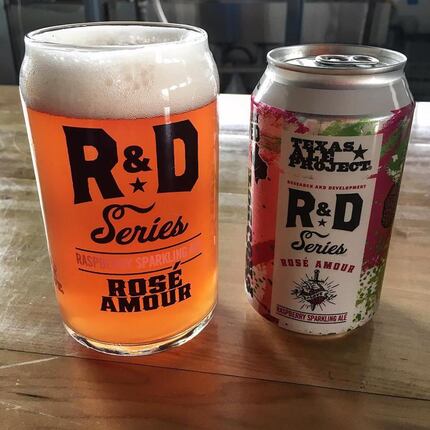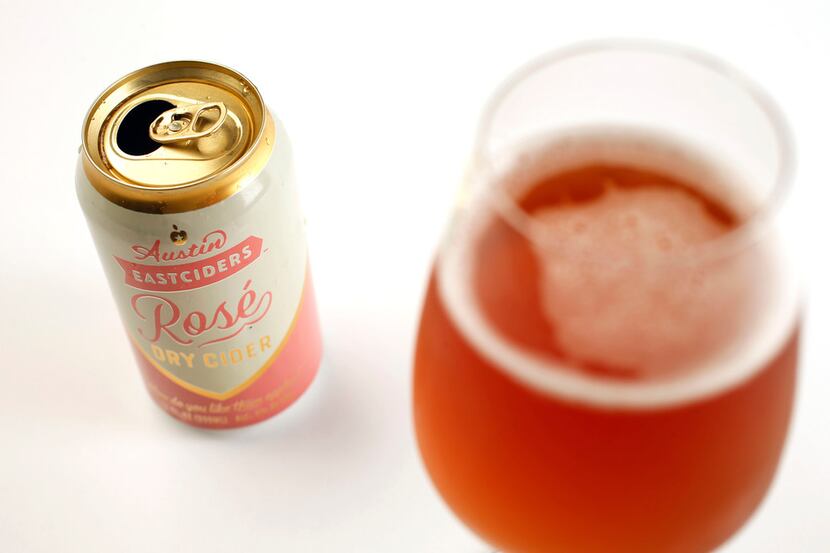Rosé all day is a phrase — scratch that, lifestyle — that’s typically reserved for avid wine drinkers. But as a slew of rosé-flavored beverages comes to market, beer and cider drinkers can officially get in on the movement.
Rosé is a citrus- and fruit-forward style of wine, defined by its characteristic pink hue, which comes from soaking red grape skins in their juice for a short period of time. Varieties range from sweet to sparkling, but how might you create a rosé flavor without using grapes? Each brewery and cidery has its own blend of ingredients.
At Texas Ale Project, assistant brewer and cellarman Preston Phillips uses pitaya, a species of dragon fruit with pink flesh, and "a lot of raspberries" in its Rosé Amour, he says. The beer is a limited release currently available in cans and on draft throughout Dallas-Fort Worth as part of the brewery's research and development series.

Inspiration for a rosé-flavored beer came about after Phillips and Texas Ale Project co-owner Brent Thompson began testing recipes to create a brut IPA, a recently popularized style that finishes crisp and dry, like a champagne. With that as the base, they added the aforementioned fruits for color and flavor. The result is a light salmon-colored beer with floral notes that dominate the aroma and taste, and are bolstered by a subtle fruit character.
“We wanted to let a lot of the actual yeast notes shine, because if there’s one thing that both me and Brent definitely agree on it’s that we don’t like over-fruited beers,” Phillips says, “nothing that will give you a headache or medicine taste after you drink a couple of them.”
At Austin Eastciders, master cidermaker Brittnay Perlo started with bittersweet and culinary apples to make the base cider, before blending in hibiscus and rose petal to create a coral-colored beverage. She’s been developing the recipe for about two years and used ingredients such as lemon verbena, strawberry leaf and cherry juice in preliminary recipes, but ultimately settled on rose and hibiscus, which offered a “super complex, but really well-rounded” flavor, she says.
The cider launched in March in cans and on draft and was immediately added to Austin Eastciders' year-round portfolio.
Wine's popularity might be one reason brewers are making beer inspired by its fermented friend. According to a 2017 Neilsen study, both wine and spirits sales outpaced beer sales, a trend that many in the industry say they are still battling. (You've likely seen a number of cocktail-inspired beers lately.)
“I’m really into it,” Perlo says. “I think it’s really cool that people just can’t get enough rosé.”
Rosé wines come in a wide array of colors and flavors, and because ingredients in beer and cider adaptations vary so widely, so too do their flavors. Texas Ale Project’s interpretation is delicate, dry and floral, while Austin Eastciders’ take is tastes is distinguishably fruit froward.
New Braunfels Brewing Co. has released several variations as part of its Jose Rose gose series. The beer is described as a salty wheat ale made with red and white grape juice. It maintains barnyard funk from the brewery's mixed cultured wild yeast, but it's far too sour and acidic to resemble the aspirational wine in question.
Still, if a name is enough to entice a wine lover to try a different beverage, brewers are hoping the flavor will inspire them to order another round.
“When you get a wine drinker to enjoy your beer,” says Phillips, “that’s the ultimate compliment.”

